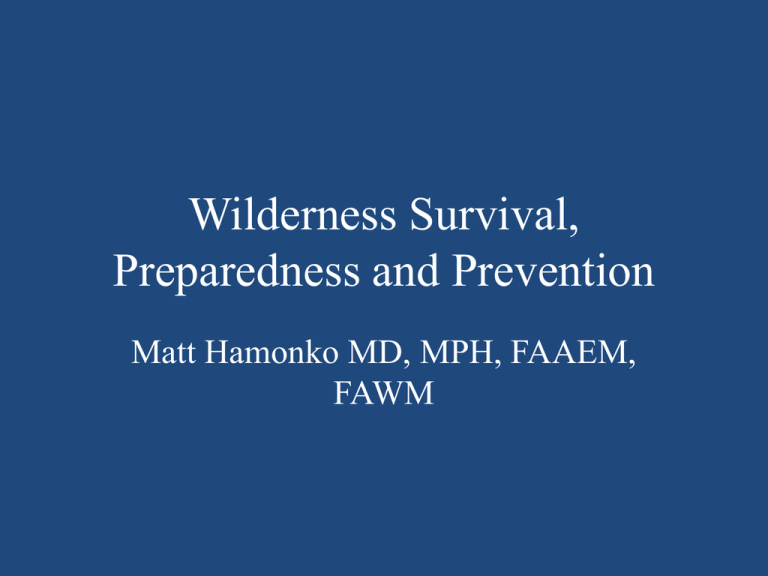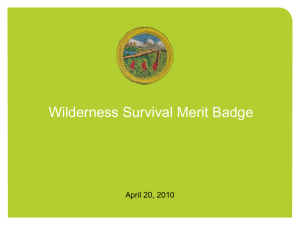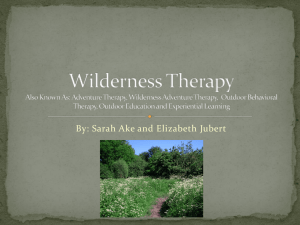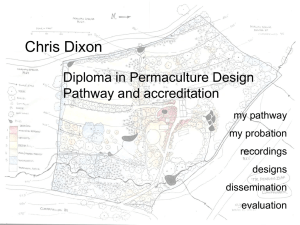Wilderness Survival, Preparedness, and Prevention by M. Opacic
advertisement

Wilderness Survival, Preparedness and Prevention Matt Hamonko MD, MPH, FAAEM, FAWM “Rule of 3’s” • • • • • 3 minutes without air 3 hours without shelter 3 days without water 3 weeks without food 3 months without hope Air • Barrier to survival = water – Solid – Liquid Air • Cause of Avalanche related mortality – Avalanche related deaths in Utah – 1989 -90 to 2005-06 season – 56 deaths – 85.7% caused by asphyxiation – 8.9% caused by asphyxiation + trauma – 5.4% caused by trauma (most head injuries) Mcintosh SE, Grissom CK, Olivares CR, Kim HS, Tremper B. Cause of Death in Avalanche Fatalities. Wilderness and Environmental Med. 2007;18:293-97. Air • General recommendations for avalanche survival – Moving snow: yell, escape off the slab, release skis, keep pack on, swim – Slowing snow: expand chest, make an air pocket with one hand and extend the other hand towards the surface • Air pocket may extend survival time up to 90 minutes – Stopped snow: relax Tremper B. Staying Alive in Avalanche Terrain. 2nd ed. Seattle, WA: Mountaineer Books; 2008. Mcintosh SE, Grissom CK, Olivares CR, Kim HS, Tremper B. Cause of Death in Avalanche Fatalities. Wilderness and Environmental Med. 2007;18:293-97. Air Grissom CK, Radwin MI. Technological Advances in Avalanche Survival. Wilderness and Environmental Med. 2002;13(2):143-52. Air • Avalung Study • 8 subjects – cases: 8 subjects using Avalung – Controls: 7 subjects breathing in 500 ml air pocket – Duration of burial, O2 saturation, heart rate, respiratory rate, end tidal CO2 and inspired CO2 – Trial stopped at subjects request, 60 minutes or O2 saturation measured below 85% Grissom CK, Radwin MI. Technological Advances in Avalanche Survival. Wilderness and Environmental Med. 2002;13(2):143-52. Air • Avalung study – mean burial time 58 minutes with Avalung, 10 minutes in controls (p = 0.001) – O2 saturation decreased to 90% in study group and 84% in control group (p = 0.018, baseline O2 sat = 96%) – ETCO2 increased to 45 mm Hg in the study group and 54 mm Hg in the control group (p = 0.018, baseline ETCO2 = 32 mm Hg) Grissom CK, Radwin MI. Technological Advances in Avalanche Survival. Wilderness and Environmental Med. 2002;13(2):143-52. Air • Avalanche Prevention – Safety course – Shovel – Probe – beacon Silverton, NA, McIntosh SE, Kim HS. Avalanche Safety Practice in Utah. Wilderness and Environmental Med. 2007;18:264-70. Air • Water Submersion Survival – Fundamentals: maintain respirations and minimize heat loss – Stay relaxed – Turn your head to breath – Remain in a curled position – Breath rhythmically as body bobs to the surface – Avoid swimming long distances (heat loss) Auerbach P. Wilderness Medicine. 5th ed. Philadelphia, PA: Mosby-Elsevier; 2007. Air • Prevention – Avoid false confidence in swimming lessons – CPR instruction – Flotation devices – Buddy swimming – Know the depth of the water • Prevention – Recognize drowning risks – Avoid alcohol and drugs – Be aware of currents – Proper training and maintenance of SCUBA diving equipment Auerbach P. Wilderness Medicine. 5th ed. Philadelphia, PA: Mosby-Elsevier; 2007. Air • Cold Water Submersion – Phase 1: cold shock 0-2 minutes • Hyperventilation, gasping, arrhythmia – Phase 2: cold incapacitation 5-15 minutes • Loss of motor control – Phase 3: onset of hypothermia 30-60 minutes – Phase 4: circum-rescue collapse Auerbach P. Wilderness Medicine. 5th ed. Philadelphia, PA: Mosby-Elsevier; 2007. Air • Cold Water Submersion – Face the direction from where you came – Put arms up on ice – Kick legs vigorously – Bring body into horizontal position – Kick and pull forward – Crawl or roll away from hole Auerbach P. Wilderness Medicine. 5th ed. Philadelphia, PA: Mosby-Elsevier; 2007. Air • Vehicle Submersion Study – Automobile with intact passenger compartment – 63 seconds before water reached bottom of windows – 150 seconds for total time to submersion – Opening door while floating decreased submersion time from 150 to 30 seconds – After water reached base of windows subjects were unable to exit until the vehicle was submerged (pressure on door and window) Geisbrecht GG, McDonald GK. My Car is Sinking: Automobile Submersion, Lessons in Vehicle Escape. Aviat Space Environ Med. 2010; 81(8): 779-84. Air • Vehicle Submersion Study – Vehicle exited easiest during flotation phase: SEATBELT-WINDOWS-CHILDREN-OUT – As the vehicle sinks it will assume a vertical engine down position – The chance of survival if the vehicle is totally submerged and on the bottom is “negligible” – Electronics should work for up to 3 minutes submerged Geisbrecht GG, McDonald GK. My Car is Sinking: Automobile Submersion, Lessons in Vehicle Escape. Aviat Space Environ Med. 2010; 81(8): 779-84. Shelter • Choosing the location – Avoid areas exposed to wind and water – Avoid valley bottoms and deep hollows (i.e. cold air sinks) – Avoid terraces that retain moisture – Camp near water but not to close ( i.e. insects) – Check for insect nests and dead trees above – Avoid spurs leading to water and game trails Wiseman J. SAS Survival Handbook. 2nd ed. Miami, Fl.: Harper Collins; 2003. Shelter • Shelter building: key points – Depends on materials available, tools available, and what you are shelter from – Consider how long you intend to stay – Consider the number in the party – Take your time and avoid sweating – Ensure adequate ventilation – Regularly clear entrances – The smaller the shelter the warmer it will be Wiseman J. SAS Survival Handbook. 2nd ed. Miami, Fl.: Harper Collins; 2003. Shelter:Fire • “The fire triangle”: air-heat-fuel • Practice, practice, practice….. • Preparation – Tinder, kindling, fuel – Choose the fireplace • Sheltered • Clear away a 2 meter in diameter perimeter • Build the fire on a platform if the ground is wet Wiseman J. SAS Survival Handbook. 2nd ed. Miami, Fl.: Harper Collins; 2003. Shelter:Fire • Tinder – Required only a spark to light • Birch bark, dried grass, wood shavings, down, waxed paper, cotton fluff, pine cones, pine needles, inner bark • Survival kit: natural cotton soaked in vasoline • Kindling – Raise the flame from the tinder • Dry twigs, soft woods, resin containing woods Wiseman J. SAS Survival Handbook. 2nd ed. Miami, Fl.: Harper Collins; 2003. Shelter:Fire • Fuel – Dry wood – Heavier/harder woods burn longer and hotter • Hickory, beech, oak – Soft woods burn fast and spark • Cedar, alder, hemlock, spruce, pine, chestnut, willow – Damp woods produce smoke • May be advantageous for repelling insects and signal fire Wiseman J. SAS Survival Handbook. 2nd ed. Miami, Fl.: Harper Collins; 2003. Shelter:Fire • Firelighting – Strike anywhere matches – Lens – Flint and steel – Battery – Fire bow – Hand drill – Hand drill Wiseman J. SAS Survival Handbook. 2nd ed. Miami, Fl.: Harper Collins; 2003. Shelter:Fire Water • Requirements – Physical and cognitive performance is decreased at 1% dehydration – Exhaustion and collapse is likely at 7% dehydration – The body can lose over 2 liters/hour by sweating – Minimum water loss per day is approx. 2.5 liters – Minimum recommended water intake per day to sustain physiological function is 1.5 liters – Should consume 1 liter/kg weight loss – Time to death after total water deprivation: 6-14 days Auerbach P. Wilderness Medicine. 5th ed. Philadelphia, PA: Mosby-Elsevier; 2007. Water • Finding water – Valley bottoms – Above high water line on coast – Rain water collection – Game trails – Straight, low flying birds at dawn and dusk – insects Wiseman J. SAS Survival Handbook. 2nd ed. Miami, Fl.: Harper Collins; 2003. Auerbach P. Wilderness Medicine. 5th ed. Philadelphia, PA: MosbyElsevier; 2007. Water:Disinfection • Infectious agents: – Bacteria, viruses, protozoa, parasites Auerbach P. Wilderness Medicine. 5th ed. Philadelphia, PA: Mosby-Elsevier; 2007. Water:Disinfection • • • • • • • • • • • • • • • E. coli Shigella Campylobacter Vibrio cholerae Salmonella Yersinia enterocolitica Aeromonas Hepatitis A Hepatitis E Norovirus Poliovirus Miscellaneous (more than 100 types) Giardia lamblia Entamoeba hystolytica Cryptosporidium Blastocystis hominis • • • • • • • • • • • • • • • Isospora belli Balantidium coli Acanthamoeba Cyclospora Ascaris lumbricoides Ancylostoma duodenale Taenia spp. Fasciola hepatica Drancunculus medinensis Strongyloides stercorlaris Trichuris trichiura Clonorchis sinensis Paragonismus westermani Diphyllobothrium latum Echinococcus granulosus Auerbach P. Wilderness Medicine. 5th ed. Philadelphia, PA: Mosby-Elsevier; 2007. Water:Disinfection • Water quality: key points – Clarity is not an indication of purity – Cloudiness indicates higher risk of impurity – Human and animal activity in the watershed is highly indicative of microbe pollution – Streams do not purify themselves – Settling effect of lakes may make them safer than streams – Groundwater is general safer than surface water Auerbach P. Wilderness Medicine. 5th ed. Philadelphia, PA: Mosby-Elsevier; 2007. Derlet RW, Carlson JR. Coliform Bacteria in Sierra Nevada Wilderness Lakes and Streams: What is the Impact of Backpackers, Pack Animals, and Cattle? Wilderness and Environmental Med. 2006;17(1):15-20. Water: Disinfection • Sierra Nevada 5-year Coliform risk factor study – 364 samples analyzed – Coliforms present • 4/47 wild site samples (9%) • 5/42 day hiker site samples (12%) • 20/111 backpacker site samples (18%) • 70/111 pack animal site samples (63%) • 51/53 cattle site samples (96%) – Backpacker vs. cattle/pack animal area (p ≤ 0.05) Derlet RW, Ali Ger K, Richards JR, Carlson JR. Risk Factors for Coliform Bacteria in Backcountry Lakes and Streams in the Sierra Nevada Mountains: a 5-Year Study. Wilderness and Environmental Med. 2008;19(2):82-90. Water:Disinfection • Terms – Clarification: reduce turbidity – Disinfection: kill or destroy nearly all disease producing microorganisms except spores – Purification: removal of organic or inorganic chemicals and particulate – Sterilization: destroy all forms of microbial life including spores. Auerbach P. Wilderness Medicine. 5th ed. Philadelphia, PA: Mosby-Elsevier; 2007. Water:Disinfection • Boiling – Kills or inactivates all enteric water borne pathogens – Old recommendation: boil for 10 minutes and add 1 minute for every 1000 ft. in elevation – New recommendation: bring to a boil (+/- for one minute) and altitude is inconsequential • WHO: bring to a boil • CDC: boil for one minute Auerbach P. Wilderness Medicine. 5th ed. Philadelphia, PA: Mosby-Elsevier; 2007. Water:Disinfection • Sedimentation – Allow large particles to settle – May reduce microorganism load by 90% – Not recommended as sole form of disinfection • Coagulation-flocculation – Chemical induced clumping and stirring (i.e. alum) – Removes 60-98% of bacteria, 65-99% viruses, 6099% giardia, 95% helminths – Not recommended as sole form of disinfection Auerbach P. Wilderness Medicine. 5th ed. Philadelphia, PA: Mosby-Elsevier; 2007. Water:Disinfection • Filtration – Rated by ability to retain particles of particular sizes • 0.2 µm enteric bacteria • 2.0 µm Giardia and Cryptosporidium cysts • 20 µm Helminth eggs and Larvae – Inadequate for 100% virus removal – 99.99% virus removal rate in 2008 published study Auerbach P. Wilderness Medicine. 5th ed. Philadelphia, PA: Mosby-Elsevier; 2007. Gerba CP, Naranjo JE, Jones EL. Virus Removal from Water by a Portable Water Treatment Device. Wilderness and Environmental Med. 2008;19(1): 45-9. Water:Disinfection • Halogens – Depends on chemical (i.e. iodine or chlorine) concentration, contact time, temperature, contaminants and pH. • • • • 1-10mg/L for 10-60 minutes considered effective Optimum pH 6.5 to 7.5 Cold temperature decreases reaction rate Contaminants may deactivate or physically block effect – May not be effective or practical for some spores Auerbach P. Wilderness Medicine. 5th ed. Philadelphia, PA: Mosby-Elsevier; 2007. Water:Disinfection • Betadine (Povidone-Iodine) Study – Betadine 10% solution – Tested at concentrations of 1:100, 1:1,000 and 1:10,000 – Coliform: E.coli – Effective bactericidal activity = 5 log reduction (99.999% kill) – 1:100 solution effective, 1:1,000 solution effective after 15 minutes of exposure Heiner JD, Hile DC, Demons ST, Wedmore IS. 10% Povidone-Iodine May Be a Practical Field Water Disinfectant. Wilderness and Environmental Med. 2010;21(4):332-36. Water:Disinfection • Ultraviolet Light – All water borne enteric pathogens are susceptible – Required clear water – Requires a power source Auerbach P. Wilderness Medicine. 5th ed. Philadelphia, PA: MosbyElsevier; 2007. Water:Disinfection • General Recommendation – Use a 2 step process • #1 filtration, sedimentation or coagulation/flocculation • #2 halogen, ultraviolet light Food • Non-obese adult male can live 60-70 days in a “clinical setting” with no food – All body fat and 1/3 of lean body mass gone • Significant loss of muscle strength after 5-10% weight loss • Greater than 50% loss of lean body mass is predictive of death • Daily recommended wilderness minimum calorie intake: men = 2900 Kcal, women 2200 Kcal Auerbach P. Wilderness Medicine. 5th ed. Philadelphia, PA: Mosby-Elsevier; 2007. Food • Recommended macronutrient composition – 50% carbohydrates – 35% fats – 15% protein • Consider vitamin depletion when: – Diet is restricted to less than 1200 to 1600 Kcal daily – Eating habits are disrupted – Increased energy expenditure Auerbach P. Wilderness Medicine. 5th ed. Philadelphia, PA: Mosby-Elsevier; 2007. Food:Procurement • Insects (most reliable source of animal food) – Avoid insects feeding on refuse – Avoid brightly colored insects (usually poisonous) – Avoid grubs on the underside of leaves (usually poisonous) – Preparation: • Most may be eating raw • May also boil, roast, grind into powder • Remove legs, wings, hairs Wiseman J. SAS Survival Handbook. 2nd ed. Miami, Fl.: Harper Collins; 2003. Food:Procurement • Insects (most reliable source of animal food) – Grasshoppers (40-50% protein) – Termites (keep for months when roasted) – Butterfly and moth larvae (37% protein, 13.7% fat) – Earthworms – Beetles and beetle larvae (head, legs, wings not digested) – Snails (boil for five minutes to remove shell) Auerbach P. Wilderness Medicine. 5th ed. Philadelphia, PA: MosbyElsevier; 2007. Food:Procurement • Mammals, amphibians, reptiles, fish – Finding game: tracks, feeding signs, droppings, rooting, scents, burrows, dens – Killing game: • Snares trap • Deadfalls trap • Spear trap • Nets (birds and fish) • Noose • Weapons (bow and arrow, sling shot) • Fishing Wiseman J. SAS Survival Handbook. 2nd ed. Miami, Fl.: Harper Collins; 2003. Food:Procurement • Plants – Indicators of toxicity • • • • • • • Milky or discolored sap Beans, bulbs or seeds within pods Spines, fine hairs, thorns Dill, carrot, parsnip or parsley like foliage Almond scent Grain heads with pink, purple or black spurs Three leaved growth pattern Auerbach P. Wilderness Medicine. 5th ed. Philadelphia, PA: Mosby-Elsevier; 2007. Food:Procurement • “The Universal Edibility Test” – Test one part at a time – Separate plant into basic components – Smell for strong or acrid odors – Do not eat for 8 hours prior to test – Place plant on elbow/wrist for 15 minutes if irritation occurs discard – Prepare the plant part how you plan to eat it Auerbach P. Wilderness Medicine. 5th ed. Philadelphia, PA: Mosby-Elsevier; 2007. Food:Procurement • “The Universal Edibility Test” (continued) – Touch the prepared part to your lips for 3 minutes – Place the plant part on tongue for 15 minutes – Chew the plant part and hold in mouth for 15 minutes DO NOT SWALLOW – If no irritation swallow the plant part – Wait eight hours, if ill effects occur induce vomiting and drink water – If no ill effects eat ¼ cup of plant, wait 8 hours Auerbach P. Wilderness Medicine. 5th ed. Philadelphia, PA: Mosby-Elsevier; 2007. Survival Preparedness and Prevention Survival Preparedness and Prevention • Zion National Park Search and Rescue statistics for the 20082009 season (N = 86) – Gender: 64.12% male – Age: 26.36% between the age of 20-29 – Location: 34.92% in mountains or foothills below 5,000 ft. – Activity: 52.33% while hiking or day walking – Contributing factors: 32.69% falls, 22.12% fatigue & physical conditioning, 21.15% insufficient info and errors in judgment, 9.62% insufficient equipment /clothing/ experience, 5.77% darkness, 2.88% heat Survival Preparedness and Prevention • Zion National Park public health cross sectional study – April-May 2010 – N = 519 – Younger individuals were more likely to carry cell phones (P=0.009), GPS units (P≤0.001) and greater than 2 liters of water (p=0.001) – Older individuals were more likely to carry food (p=0.02) – 90% checked the weather, 91.9% first aid kits, 77.5% map, 37.0% compass, 24.9% GPS, 4% locator device, 75.9% cell phones Survival Preparedness and Prevention • Search and Rescue (SAR) Studies – 12,337 SAR operations in U.S. National Parks from 2003 to 2006 with 522 fatalities – 3,912 cases associated with day hiking – 18% activated by cell or satellite phone call – Utah 2001-2005: 1190 SAR operations • 185 cases associated with insufficient clothing, or experience, 81 associated with adverse weather Heggie TW, Heggie TM. Search and Rescue Trends Associated with Recreational Travel in US National Parks. Journ of Travel Med. 2009;16(1): 23-7. Heggie TW, Heggie TM. Search and Rescue Trends and the Emergency Medical Services Workload in Utah’s National Parks. Wilderness and Environ Med. 2008;19:164-71. Survival Preparedness and Prevention • Search and Rescue Studies – Shenandoah National Park 2003-2007 • Most operations associated with trauma to the lower extremities while hiking rather than medical illness – Yellowstone National Park 2003-2004 • 38% of operations related to hiking or walking • 77.4% of trauma were soft tissue and 56% involved the lower extremities • 8.3% of operations were related to dehydration, hypovolemia or hunger (most common non-traumatic cause) Forrester JD, Holstege CP. Injury and Illness Encountered in Shenandoah National Park. Wilderness and Environ Med. 2009;20:318-26. Johnson RM, Huettl B, Kocsis V, Chan SB, Kordick MF. Injuries Sustained at Yellowstone National Park Requiring Emergency Medical System Activation. Wilderness and Environ Med. 2007;18:186-9. Survival Preparedness and Prevention • Canadian Study (Banff, Yoho, and Kootenay National Parks) 2003-2006 Reason for Rescue Number Percent Slips and falls 159 50.2% Lost/stranded/overdue 65 20.5% Nontraumatic medical reason 54 17% Objective danger 22 6.9% Inexperience/inadequate equipment 10 3.2% Other 7 2.2% Finlay JW. Epidemiology of Mountain Search and Rescue Operations in Banff, Yoho, and Kootenay National Parks, 2003-06. Wilderness and Environmental Med. 2008;19(4):245-51 Survival Preparedness and Prevention • NOLS packweight and injury study Variable OR P-value 95% CI Packweight (kg) 1.07 0.17 0.97, 1.17 Height (cm) 0.97 0.20 0.93,1.01 Body weight (kg) 0.99 0.59 0.96, 1.03 Packweight/ body 1.05 weight ratio 0.09 0.99, 1.11 Age 1.01 0.67 0.97, 1.06 Male Gender 1.84 0.13 0.84, 4.02 Hamonko MT, McIntosh SE, Schimelpfenig T, Leemon D. Injuries Related to Hiking with a Pack During National Outdoor Leadership School Courses: A Risk Factor Analysis. Wilderness and Environmental Medicine. 2011;22(1):2-6. Personal Survival Kits • Recommended Components: – Fire-building: strike anywhere matches, candle, cotton+vaseline, knife, metal match – Shelter-Building: parachute chord, tarp, folding saw – Signaling equipment: headlamp, whistle, notebook, pencil, signaling mirror, orange tape Auerbach P. Wilderness Medicine. 5th ed. Philadelphia, PA: MosbyElsevier; 2007. Personal Survival Kits References • • • • • • • • • • Mcintosh SE, Grissom CK, Olivares CR, Kim HS, Tremper B. Cause of Death in Avalanche Fatalities. Wilderness and Environmental Med. 2007;18:293-97. Tremper B. Staying Alive in Avalanche Terrain. 2nd ed. Seattle, WA: Mountaineer Books; 2008. Grissom CK, Radwin MI. Technological Advances in Avalanche Survival. Wilderness and Environmental Med. 2002;13(2):143-52. Silverton, NA, McIntosh SE, Kim HS. Avalanche Safety Practice in Utah. Wilderness and Environmental Med. 2007;18:264-70. Auerbach P. Wilderness Medicine. 5th ed. Philadelphia, PA: Mosby-Elsevier; 2007. http://www.umanitoba.ca/faculties/physed/research/people/giesbrecht/Thin_Ice.pdf Geisbrecht GG, McDonald GK. My Car is Sinking: Automobile Submersion, Lessons in Vehicle Escape. Aviat Space Environ Med. 2010; 81(8): 779-84. Wiseman J. SAS Survival Handbook. 2nd ed. Miami, Fl.: Harper Collins; 2003. Derlet RW, Carlson JR. Coliform Bacteria in Sierra Nevada Wilderness Lakes and Streams: What is the Impact of Backpackers, Pack Animals, and Cattle? Wilderness and Environmental Med. 2006;17(1):15-20. Derlet RW, Ali Ger K, Richards JR, Carlson JR. Risk Factors for Coliform Bacteria in Backcountry Lakes and Streams in the Sierra Nevada Mountains: a 5-Year Study. Wilderness and Environmental Med. 2008;19(2):82-90. References • • • • • • • • Gerba CP, Naranjo JE, Jones EL. Virus Removal from Water by a Portable Water Treatment Device. Wilderness and Environmental Med. 2008;19(1): 45-9. Heiner JD, Hile DC, Demons ST, Wedmore IS. 10% Povidone-Iodine May Be a Practical Field Water Disinfectant. Wilderness and Environmental Med. 2010;21(4):332-36. Heggie TW, Heggie TM. Search and Rescue Trends Associated with Recreational Travel in US National Parks. Journ of Travel Med. 2009;16(1): 23-7. Heggie TW, Heggie TM. Search and Rescue Trends and the Emergency Medical Services Workload in Utah’s National Parks. Wilderness and Environ Med. 2008;19:164-71. Forrester JD, Holstege CP. Injury and Illness Encountered in Shenandoah National Park. Wilderness and Environ Med. 2009;20:318-26. Johnson RM, Huettl B, Kocsis V, Chan SB, Kordick MF. Injuries Sustained at Yellowstone National Park Requiring Emergency Medical System Activation. Wilderness and Environ Med. 2007;18:186-9. Finlay JW. Epidemiology of Mountain Search and Rescue Operations in Banff, Yoho, and Kootenay National Parks, 2003-06. Wilderness and Environmental Med. 2008;19(4):245-51 Hamonko MT, McIntosh SE, Schimelpfenig T, Leemon D. Injuries Related to Hiking with a Pack During National Outdoor Leadership School Courses: A Risk Factor Analysis. Wilderness and Environmental Medicine. 2011;22(1):2-6.






